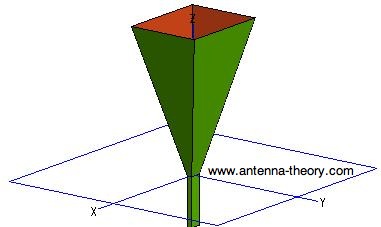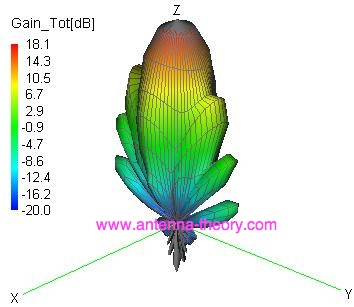Horn Antenna - Radiation Patterns
|
To give an idea of the radiated fields from a horn antenna, a specific example will be given.
The waveguide dimensions
are given by a=3.69 inches, b=1.64 inches,
 Figure 1. Horn antenna described above. This antenna is simulated using a commercial solver, FEKO (which runs method of moments). The radiation pattern at 2 GHz is shown in Figure 2.
 Figure 2. Horn radiation pattern at 2 GHz. The gain of the horn is 18.1 dB in the +z-direction. The half-power beamwidth is 15 degrees in the xz-plane (H-plane) and 11 degrees in the yz-plane (E-plane).
The gain at 1.5 GHz is -2.54 dB, approximately 20 dB lower than at 2 GHz. The waveguide feed acts as a high-pass filter; it blocks energy below its 'cutoff' frequency and passes energy above this level. At 2.5 GHz, the gain increases slightly to 18.8 dB.
The horn antenna geometry affects its antenna gain. For a desired antenna gain, there are tables and graphs that can be consulted in antenna handbooks that describe the optimal geometry in terms of the length and aperture size of the horn. However, this optimal geometry is only valid at a single frequency. Since horn antennas are to operate over a wide frequency band, they are often designed to have optimal gain at the lowest frequency in the band. At higher frequencies, the geometry is no longer optimal, so the E-field across the aperture is not optimal. However, the horn's aperture becomes electrically larger at higher frequencies (the aperture is more wavelengths long as the frequency increases or the wavelength decreases). Consequently, the loss of an optimal aperture field is offset by an electrically larger horn, and the antenn again actually increases as the frequency increases. See this link for calculating the radiation pattern of horn antennas from the Fourier Transform.
|
Antennas (Home)
 inches,
A=30 inches, and B=23.8 inches. This horn is somewhat large, and will work well
above roughly 2 GHz. Horns made for higher frequencies are smaller. This horn antenna, with a waveguide
feed is shown in Figure 1.
inches,
A=30 inches, and B=23.8 inches. This horn is somewhat large, and will work well
above roughly 2 GHz. Horns made for higher frequencies are smaller. This horn antenna, with a waveguide
feed is shown in Figure 1.